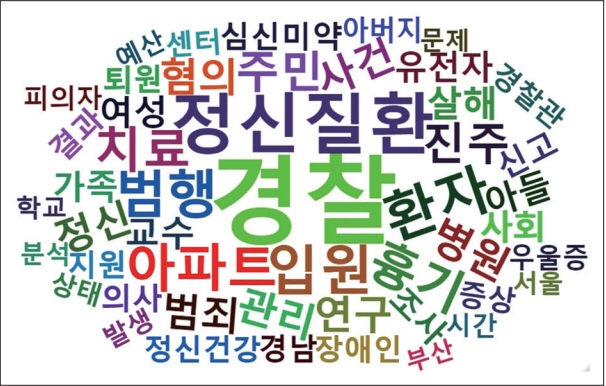Korean J Schizophr Res.
2020 Oct;23(2):58-64. 10.16946/kjsr.2020.23.2.58.
Text-Mining Analyses of News Articles on Schizophrenia
- Affiliations
-
- 1Department of Psychiatry, Seoul Medical Center, Seoul, Korea
- 2Department of Psychiatry, Chonnam National University Medical School, Gwangju, Korea
- KMID: 2508353
- DOI: http://doi.org/10.16946/kjsr.2020.23.2.58
Abstract
Objectives
In this study, we conducted an exploratory analysis of the current media trends on schizophrenia using text-mining methods.
Methods
First, web-crawling techniques extracted text data from 575 news articles in10 major newspapers between 2018 and 2019, which were selected by searching “schizophrenia” in the Naver News. We had developed document-term matrix (DTM) and/or term-document matrix (TDM) through pre-processing techniques. Through the use of DTM and TDM, frequency analysis, cooccurrence network analysis, and topic model analysis were conducted.
Results
Frequency analysis showed that keywords such as “police,” “mental illness,” “admission,” “patient,” “crime,” “apartment,” “lethal weapon,” “treatment,” “Jinju,” and “residents” were frequently mentioned in news articles on schizophrenia. Within the article text, many of these keywords were highly correlated with the term “schizophrenia” and were also interconnected with each other in the co-occurrence network. The latent Dirichlet allocation model presented 10 topics comprising a combination of keywords: “police-Jinju,” “hospital-admission,” “research-finding,” “care-center,” “schizophrenia-symptom,” “society-issue,” “family-mind,” “woman-school,” and “disabled-facilities.”
Conclusion
The results of the present study highlight that in recent years, the media has been reporting violence in patients with schizophrenia, thereby raising an important issue of hospitalization and community management of patients with schizophrenia.
Keyword
- Media; News; Schizophrenia; Text-mining; Violence; 기사; 언론; 조현병; 텍스트 마이닝; 폭력
Figure
Cited by 2 articles
-
Characteristics of Impulsive and Premeditated Aggression Subtypes in Patients with Schizophrenia in South Korea Who Committed a Crime
Minah Kim, Yongwoo Jo, Tae Young Lee, Kyung-Ok Lim, Jun Soo Kwon
Korean J Schizophr Res. 2021;24(1):8-16. doi: 10.16946/kjsr.2021.24.1.8.Current Status and Future Direction of Media Guidelines on Mental Illness
Jung Suk Lee
Korean J Schizophr Res. 2023;26(2):41-45. doi: 10.16946/kjsr.2023.26.2.41.
Reference
-
1. Kim A. Government announces measures to deal with mental illness in light of rise in crimes. The Korea Herald. 2019. May. 15. Available from URL: http://www.koreaherald.com/view.php?ud=20190515000759.2. Korean Society for Schizophrenia Research. Statement from the Korean Society for Schizophrenia Research on the police officer killed. The Korean neuropsychiatric association newsletter. 2018. July. 16. Available from URL: http://www.knpanews.or.kr/news/articleView.html?idxno=69.3. Corrigan P. How stigma interferes with mental health care. Am Psychol. 2004; 59:614–625.
Article4. Lauber C, Rossler W. Stigma towards people with mental illness in developing countries in Asia. Int Rev Psychiatry. 2007; 19:157–178.
Article5. Corrigan PW, Penn DL. Lessons from social psychology on discrediting psychiatric stigma. Am Psychol. 1999; 54:765–776.
Article6. Park JI, Jeon M. The stigma of mental illness in Korea. J Korean Neuropsychiatr Assoc. 2016; 55:299–309.
Article7. Goepfert NC, von Heydendorff SC, Dreßing H, Bailer J. Effects of stigmatizing media coverage on stigma measures, self-esteem, and affectivity in persons with depression-an experimental controlled trial. BMC Psychiatry. 2019; 19:138.
Article8. Krippendorff K. Content analysis: an introduction to its methodology. Thousand Oaks: Sage;2013.9. Rajman M, Besançon R. Text Mining: natural language techniques and text mining applications. Spaccapictra S, Maryanski F, editors. Data mining and reverse engineering. Boston: Springer;1998.10. Cho J, Garcia-Molina H, Page L. Efficient crawling through URL ordering. Comput Netw Isdn Sys. 1998; 30:161–172.
Article11. Wickham H. rvest: Easily Harvest (Scrape) Web Pages. R package version 0.3.4. 2019.12. Feinerer I, Hornik K. tm: Text Mining Package. R package version 0.7-6. 2018.13. Jeon H. KoNLP: Korean NLP Package. R package version 0.80.1. 2016.14. Baek YM. Ext-mining using R. Paju: Hanulmplus;2017.15. Lang D, Chien GT. wordcloud2: create word cloud by ‘htmlwidget’. R package version 0.2.1. 2018.16. Lee SS. A Content analysis of journal articles using the Language Network Analysis Methods. J Korean Soc Inform Manage. 2014; 31:49–68.
Article17. Epskamp S, Cramer AOJ, Waldorp LJ, Schmittmann VD, Borsboom D. Qgraph: network visualizations of relationships in psychometric data. J Stat Softw. 2012; 48:18.
Article18. Blei DM, Lafferty JD. A correlated topic model of science. Ann Appl Stat. 2007; 1:17–35.
Article19. Blei DM, Ng AY, Jordan MI. Latent dirichlet allocation. J Mach Learn Res. 2003; 3:993–1022.20. Roberts M, Stewart B, Tingley D. Stm: R package for structural topic models. J Stat Softw. 2019; 91:1–40.21. Chang J. Lda: collapsed Gibbs sampling methods for topic models. R package version 1.4.2. 2015.22. Griffiths TL, Steyvers M. Finding scientific topics. Proc Natl Acad Sci U S A. 2004; 101(Suppl 1):5228–5235.
Article23. Kim SW, Yoon JS, Lee MS, Lee HY. The analysis of newspaper-articles on psychosis. J Korean Neuropsychiatr Assoc. 2000; 39:838–848.24. Lee MS, Ko JA, Oh JH, Shin YS, Park JS. Trend of internet media report for mental health and suicide. J Korean Assoc Soc Psychiatry. 2009; 14:97–104.25. Paek HJ, Cho HJ, Kim JH. Content analysis of news coverage on stigma and attribution regarding mental illness. Korean J Journalism Commun Stud. 2017; 61:7–43.26. Hwang A, Na EY. Content analysis of news coverage with regard to mental health: focusing on news frame and tone. Health Soc Welf Rev. 2018; 38:290–322.27. Choi JW, Han HS, Lee M, An JM. The prediction of corporate bankruptcy using text-mining methodology. Product Rev. 2015; 29:201–228.28. Kang B, Song M, Jho W. A study on opinion mining of newspaper texts based on topic modeling. J Korean Soc Lib Inf Sci. 2013; 47:315–334.
Article29. Koike S, Yamaguchi S, Ojio Y, Ohta K, Ando S. Effect of name change of schizophrenia on mass media between 1985 and 2013 in Japan: a text data mining analysis. Schizophr Bull. 2016; 42:552–559.
Article
- Full Text Links
- Actions
-
Cited
- CITED
-
- Close
- Share
- Similar articles
-
- Text Mining in Biomedical Domain with Emphasis on Document Clustering
- Public Perceptions of Male Hormone Levels and Prostate Health: A Text Mining Analysis of South Korean Media and Online Communities
- Cancer-related Keywords in 2023: Insights from Text Mining of a Major Consumer Portal
- Analysis of Headline News about Nurses Before and After the COVID-19 Pandemic
- Analysis of Women's Health Online News Articles Using Topic Modeling



